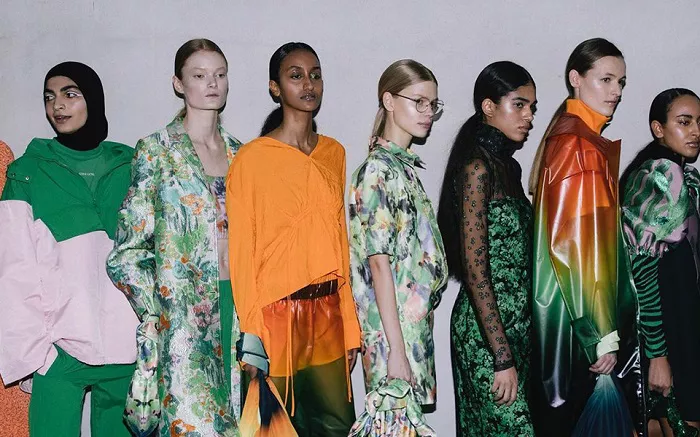To truly appreciate what makes Copenhagen Fashion Week stand out among global fashion capitals, one must look beyond the runway trends and the iconic rosette hair clips and oversized scrunchies. The real magic lies in the designers taking their final bow.
Copenhagen’s Spring 2025 season kicked off with Stephanie Gundelach and Awa Malina Stelter of Friends and ÓperaSport. They showcased midi dresses with ruching and bow-adorned mini bags. The week closed with Jeanette Madsen and Thora Valdimars of Rotate, presenting semi-sheer, butter-yellow party dresses and stylish daytime suits. Each day featured collections designed by women, for women, reflecting a strong sense of the audience and the models on the runway.
In 2024, having women design for women should not be remarkable. Yet, in the United States, finding women-led brands requires extra effort due to their scarcity. In contrast, Copenhagen stands out for its gender parity. Among the major international fashion weeks, Copenhagen leads with 63 percent of brands having women in top creative roles. Many of these women are also the founders and CEOs of their brands.
This focus on a female perspective is not just for marketing but is woven into every collection. The designs reflect practicality and inclusivity. At Mark Kenly Domino Tan, there were minimalist separates with a touch of Prada’s elegance. A.Roege Hove offered accordion-pleated 3-D knits, while The Garment presented airy chiffon tube dresses. Editors around me whispered their approval, resonating with the practicality and wearability of the pieces.
Styling at Copenhagen Fashion Week was both accessible and realistic. Sanne Sehested of Gestuz featured fringe jackets and tie-dye prints reminiscent of rock legends. Skall Studio, run by sisters Marie and Julie Skall, offered creamy trench coats and relaxed shirt dresses. These collections are easily adaptable to real life.
The runway also showcased a diverse range of models. Every show included middle-aged and older models, as well as mid-size and curvy bodies, making these appearances a regular feature rather than a novelty. Sinéad O’Dwyer, a new addition to the calendar, presented a mostly curvy cast in her subversive cut-out designs and made history with Copenhagen’s first blind model, accompanied by her guide dog. This approach reflected a broader and more inclusive vision of beauty.
Fashion trends like sheer fabrics and micro shorts were presented in practical, wearable ways. When styled with oversized shirts or paired with blazers and jeans, these trends felt accessible and inclusive. This approach captured a nuanced view of modern womanhood, akin to Greta Gerwig’s portrayal of Barbie’s world—minus the excessive pink.
Copenhagen Fashion Week’s women designers are not limited by a gender binary. Sophie Bille Brahe, a renowned jeweler, designs pieces like diamond rings and bow-shaped pearl earrings for everyone. Her inclusive vision extends to all genders.
Designers in Copenhagen understand their audience deeply. Stephanie Gundelach of ÓperaSport highlights how their designs are informed by lived experiences. “We use seamless recycled silk because it fits every woman, regardless of age or shape,” she says. Both Gundelach and Stelter, who are mothers, emphasize the importance of practical and comfortable designs with a touch of elegance.
Barbara Potts and Cathrine Saks of Saks Potts shared a collection for their tenth anniversary, including polos, faux fur jackets, and day dresses. They design based on their personal preferences and the needs of their friends, not solely for empowerment. Their approach reflects a broader industry trend where women-led brands focus on practical and stylish designs.
Denmark’s supportive environment for women in fashion is notable. It ranks high on the European Institute for Gender Equality’s index. While there is a gender wage gap, Denmark’s supportive maternity and paternity leave policies help women balance work and family life. Rikke Baumgarten of Baum und Pferdgarten appreciates the country’s progressive stance on women’s rights and its supportive educational system.
Despite these advances, Copenhagen Fashion Week’s designers still face global challenges. Barbara Potts recalls how starting her brand at a young age meant navigating skepticism from older, male investors. However, the strength of their friendship and their determination helped them succeed.
Copenhagen Fashion Week has also fostered a supportive environment amid global retail challenges. CEO Thorsmark highlighted the tough times in retail but noted the community’s resilience. Ganni, a leading Copenhagen brand, paused its shows to invest in emerging designers and sponsored an exhibition focusing on sustainable textiles. For Spring 2025, Ganni collaborated with new labels and New Balance on a co-designed sneaker, introducing fresh talent to a global audience.
Camaraderie prevails over competition in Copenhagen’s fashion scene. Caroline Bille Brahe, whose Caro Editions debuted this season, received significant support from industry peers. She describes her experience as one of mutual encouragement and collaboration.
Support and commercial success are valued equally in Copenhagen. The city’s fashion week reflects a diverse and enthusiastic network, where real-life experiences and inclusivity are central. ÓperaSport’s founders hope to see their designs embraced by women of all shapes and sizes.
In Copenhagen, the spirit of collaboration and support shines through. This community-focused approach highlights the city’s unique position in the fashion world, where inclusivity and practicality are celebrated alongside creativity and style.
Related topics:
- Scottsdale Fashion Week Announces Casting Calls For Upcoming Event
- ESMOD International COO Shares Insights With ESMOD Kuala Lumpur Students
- WNBA Players Make Waves In Fashion World This Summer

